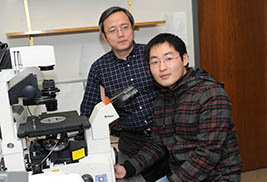Featured Article
Kent State Physics Professor Publishes Exact Solution to Model Big Bang and Quark Gluon Plasma
Unlike in mathematics, it is rare to have exact solutions to physics problems.
read moreNational Science Foundation Grant Funds Kent State Scientist’s Study of Structure in the Human Chromosome
Posted Feb. 2, 2015 | Cindy Weiss
Hanbin Mao, Ph.D., left, associate professor of
chemistry and biochemistry at Kent State University, and
graduate student Yue Li from Kyoto University in Japan
work in Mao's lab at Kent State. Mao collaborates with
researchers in Japan on single molecule research on a
chromosome structure.
A Kent State University scientist has received a $450,000 grant from the National Science Foundation (NSF) to lead a study of the workings and dynamics of a structure inside the human chromosome.
Hanbin Mao, Ph.D., associate professor of chemistry and biochemistry in Kent State’s College of Arts and Sciences, will study G-quadruplex structures (GQs), which are located in the telomeres at the end of chromosomes. Telomeres protect genetic information in chromosomes but are also associated with aging and cancer, among other things. This fundamental research on the telomere could eventually lead to the design of new anti-cancer drugs targeted to the GQs.
Mao, whose earlier work in this area was funded by a $278,000 NSF grant, collaborates with a researcher in Japan, Hiroshi Sugiyama, Ph.D., at Kyota University. Mao is the principal investigator on the project.
The researchers will study GQs at the single molecule level, applying techniques such as molecular scalpels and laser tweezers, which offer a way to precisely manipulate and measure the mechanical force on molecular structures. They also will use “click chemistry,” which is the use of chemical building blocks that “click” or link together readily.
Their goal is to see how GQ units are structured and how they are distributed in human telomeres.
Two Ph.D. students will be involved in the project. Mao also envisions including undergraduates on the research team. Since 2005, his laboratory has trained 16 undergraduates, many of whom have pursued advanced degrees in science. He also has trained high school students in research and plans to have one or two high school students involved each year of the three-year project. His lab has hosted high school students through the Upward Bound summer program and as interns.
“Contrary to the common belief that high school students are not ready for scientific research, we found that the majority of students are enthusiastic in carrying out hands-on experiments,” he wrote in his proposal to the NSF.
For more information about Kent State’s Department of Chemistry and Biochemistry, visit www.kent.edu/chemistry.
To learn more about research at Kent State, visit www.kent.edu/research.